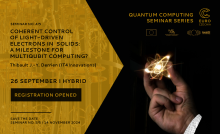Course/Event Essentials
Event/Course Start
Event/Course End
Event/Course Format
Mixed
Primary Event/Course URL
Training Content and Scope
Scientific Domain
Technical Domain
Level of Instruction
Beginner
Intermediate
Sector of the Target Audience
Research and Academia
Industry
Public Sector
Language of Instruction
Other Information
Organiser
Supporting Project(s)
EuroCC2/CASTIEL2
